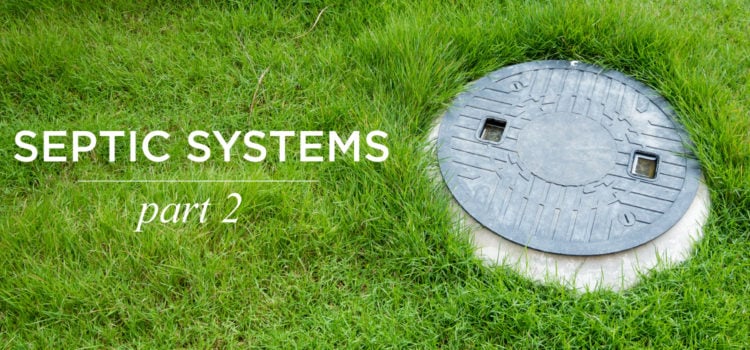Getting A Septic Inspection
This is the second installment of a four-part series about private, on-site waste management systems.
By Deborah Rutter
In PART 1: Understanding Septic Systems and How They Work, we took a close look at the overall approach to how a system like this is set up, and how it works. In this Part 2: Getting A Septic Inspection, we will look at why you should get all private septic systems inspected, regardless of age, what a good inspection entails, and some general approaches to the most common issues.
If you are buying a house, chances are you are also requesting some sort of inspection by a professional third-party to help you find the issues, plan expenses for the future, and if things are really bad, negotiate with the seller or maybe even rethink your purchase altogether. It’s not likely you’d tell that inspector to ignore the roof, overlook the plumbing, or just pass over any electrical issues. Likewise, you shouldn’t avoid a septic inspection! Your septic system is the key component for all waste water: toilets, showers, washing machine, dishwashers, and sinks.

Imagine if NONE of those could be used at some point due to a failing septic system which could have been spotted via a good overview. In this article, you’ll find the components of a good overview…
Most states require septic inspectors and pumpers to hold a state-level license. Your real estate agent should be able to make a strong, trusted recommendation for a local company who does good, timely, affordable work. If they can’t, you might be working with an agent who doesn’t have a lot of experience with rural purchases. Most septic inspection companies install new systems, perform regular maintenance on installed systems, can help with updates and upgrades and can troubleshoot and solve emergencies. After your purchase closes, if you have had a good experience with your inspection process, you may have just found the company to help you maintain your system longer term. Sure, you won’t have a sewer bill every month, but like any system, routine maintenance is key to avoiding expensive and badly-timed problems (and they are all badly timed!).

Once you have found a reputable company, set up a date and time for the inspection. Having it on the same day as a home inspection is a good option logistically. You, your buyer agent and the seller can all work together to figure out the best timing. A septic inspection doesn’t require the home to be vacant or not-used during the inspection. In fact, more water running through the system is better!
A reputable company will show up on time (or let you know if they are running late) and come ready to dig. Complete inspections for a conventional system involve digging up the outgoing lid of the tank itself, which maybe a few inches below ground, or many feet. Getting the permit for the septic system (either from the seller or the county/state/city records is key) can help avoid a second trip if the tank is too deep to access by a hand shovel (and might then put you outside of your inspection window). The permit will also confirm if the size of the house is consistent with the septic permit. Many sellers add square footage but fail to adjust the size of the septic system to match.
Once the lid is accessed and and off a whole host of things can be assessed: The depth of the tank, if the tank is leaking, the age and construction materials and size of the tank. A lot of things! If we see evidence of grease, feminine hygiene products or other non-compostible items, we know that the sellers have been door a poor job of taking care of their system and it warranty closer scrutiny. The ONLY thing should go into a septic system is plain waste water, human waste and septic-safe toilet paper. Nothing else. Evidence of grease or other items wears the system out faster, can clog up the leach field, break any grinders or pumps.

From here, the tank is pumped. Hopefully the tank is accessible and the area to the tank location is free of building, shrubs, trees, etc. if it’s not? Now is a good time to find out. I have seen a tank UNDER a poured concrete patio slab, so you really need to know exactly where the tank is located. It needs to be accessible. If the lid is hidden, and can not be opened, a proper pumping can not occur—no reputable inspection company will allow this to happen. Lots of sellers don’t realize that their tank should be pumped every 3-5 years. Each occurrence can take more than an hour to pump, depending on the size of the tank.
Next is digging up the distribution box which is slightly downhill from the tank (or possibly uphill with a pump, depending on the best place the permitting process identified). These are typically concrete or plastic, which digging up will confirm. Is the lid on tight, or has dirt fallen into the box? Are all the lines to the leach filed all taking water equally, indicating a failed line? Is there waste in the box, not just water? Digging the box not only tell you where it is located (and what to protect from trees, fencing or other things getting put on top) but the health of the leach field, too.
A good inspection company is key to this process and a reputable buyer agent working in rural properties should have a clear understanding of the options and pricing in your area as well as who does (and doesn’t) do a great job. Managing waste on-site is simple, elegant and for the affordable if you keep your system inspected, pumped and maintained!
